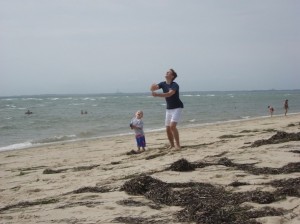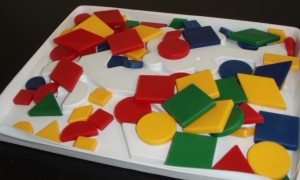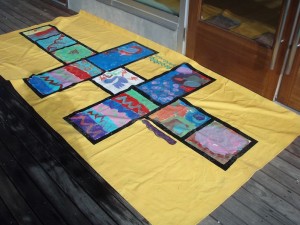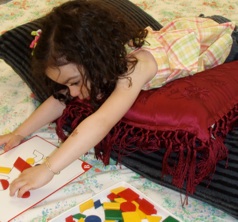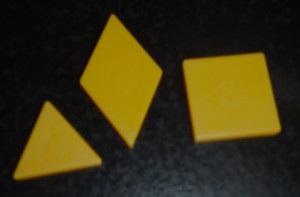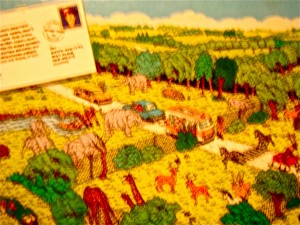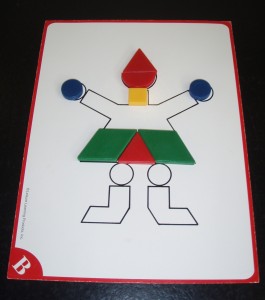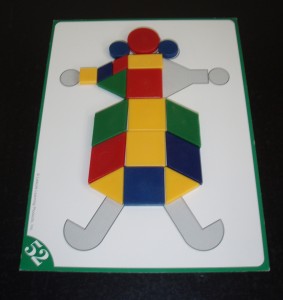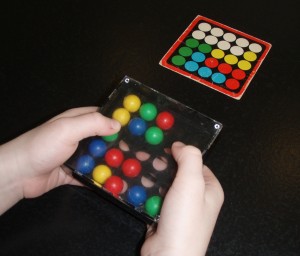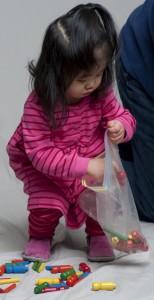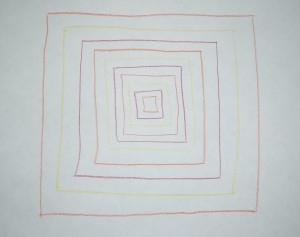First you may be asking “WHY would visual perception be found on a website called “The Motor Story?” The short answer is that early movement helps develop concepts related to form (round, square, curvy, big, little) and space (how far away, how big, concepts of right, left, up and down).Touch and movement develop spatial concepts important to understanding the world we SEE.
Sensory Motor Exploration Builds the Foundation for Visual Perception and Spatial Reasoning
When the infant first reaches out to bat at a toy or touch Mommy’s face, the concept of distance begins to develop. When the toddler reaches for a cup of milk and knocks it over, assessing distance becomes even better. Crawling to a toy initially is an arduous task. Getting there quickly (because the toy is close at hand) or struggling across the room is remembered. As the “motor memory” is forming, associated visual information is being stored.
Feeling a round ball or the sharp corner of the coffee table when cruising all help develop an understanding of shapes. Picture books identifying shapes can be helpful, but keep in mind that they present a two dimensional image of shapes. There is so much more learning that occurs when the child actually holds an elliptically shaped object.
Asking the child to climb “up” develops the spatial concept of “up” or vertical. Climbing under the table begins to develop a sense of “Spatial Relationships.” Tossing a ball in the sky and waiting for it to come down, expands the spatial concepts of up and down beyond the child’s personal space to his or her relationship with other objects.
“Put the yellow block next to the red one” not only helps teach colors, it further develops the relationship between objects in space. As the child gets older you can refine this to “Place the rectangular block to the left of the square one.”
Gross motor games involving imitation of movement not only establishes body awareness, it helps develop a sense of how the body moves (to the right, left) and over time this can be reversed to see the other person’s perspective (The dance teacher’s right and left vs yours). Simple games like Hop Scotch extend the understanding to the immediate environment.
Core strength is necessary to develop focus and attention:
The child needs to be able to sit upright and focus to look carefully at picture books and discern salient details. If the child struggles or gets tired while sitting up, it makes it difficult if not impossible to pay attention to specific visual information.
Components of Visual Perception and Spatial Reasoning:
Recognition of form: Is it round or square, a curve or a straight line?
Figure Ground: being able to discern objects or pictures imbedded in others (like Hidden Pictures), determining what visual details are important to hold onto.
Shape Discrimination: Recognizing specific shapes. Many children struggle to detect the difference between a square and a diamond.
Spatial Relationships: Understanding how shapes fit together or in relationship with each other. This must occur before a child can discern the lines and curves that create numbers and letters. Note the increased difficulty of this second puzzle. (Pictured-Super Minds*)
Spatial Relationships: Understanding how shapes fit together or in relationship with each other. This must occur before a child can discern the lines and curves that create numbers and letters. Note the increased difficulty of the second puzzle. (Pictured-Super Minds*)
Spatial Relationships includes recognition of space: big or little, high or low, above, under, right, left, the middle.
Recognition of patterns
Being able to see a design and then reproduce it is a wonderful challenge. The “Tricky Fingers”* is a wonderful activity which strengthens finger muscles while challenging visual perceptual skills. Reproducing designs can also be done with blocks, beads, elastic bands (Geoboards), cut out pieces of cardboard and construction paper.
Visual Memory: Remembering what you see; holding onto the specificity of images such as symbols (letter, numbers), recall of colors. Visual Memory is critical for writing, drawing, working with number and reading.
Visual Closure: Being able to predict how a form will be completed to make sense.
Skills and activities to work on for each age group are found in the links below:

